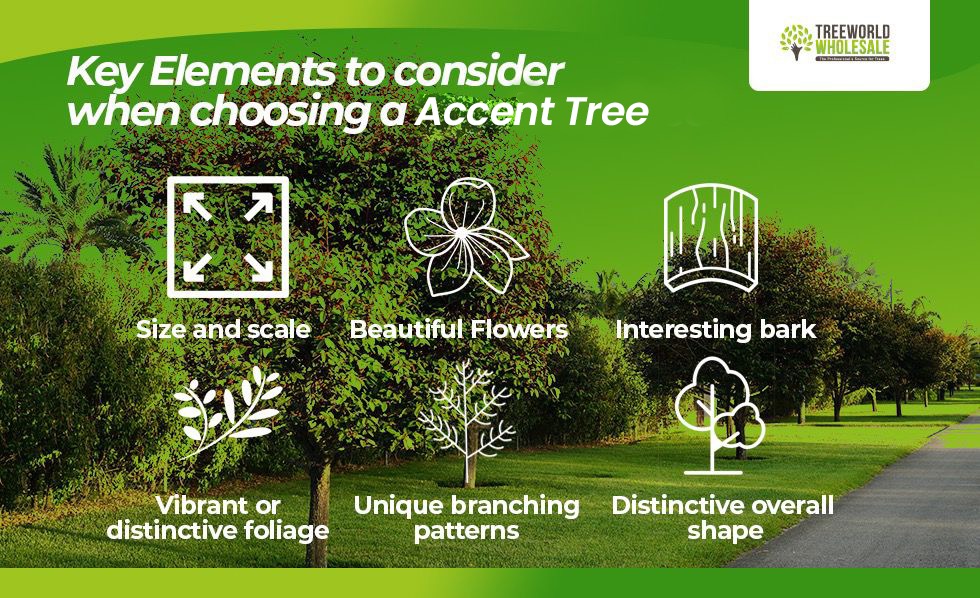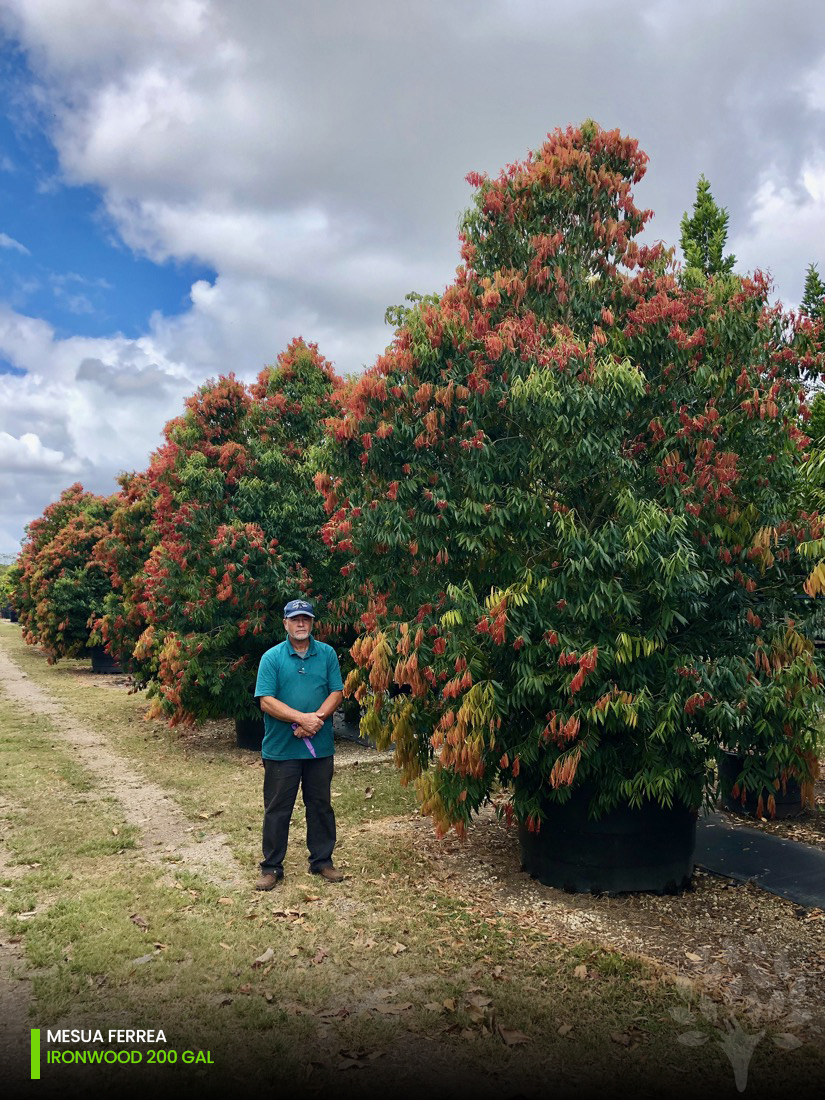An accent tree is somewhat like a statement piece in landscape design! An accent tree is a distinctive, eye-catching item or element within a space that immediately draws attention and makes a bold visual impact. It typically has a standout feature that acts as a focal point, adding personality to your garden. While becoming a key element in landscaping projects.
What exactly is an accent tree? Definition
An accent tree is a specific tree that is carefully chosen and planted in a noticeable location, usually for its attractive appearance. With unique qualities of size, shape, color, texture, flowers, or leaves. That makes them stand out and become a focal point in gardens, parks, or landscape designs.
Furthermore, either as individual accent trees or in small groups, they accentuate their unique features and generate visual interest in the landscape design. Strategically placed in areas where they are appreciated.
Consequently, we can admire everything that has a significant impact. This includes vibrant blossoms, striking foliage, or the majestic presence of arching branches. Equally important are smaller details, such as the attractive and peeling bark of the Eucalyptus deglupta.
Moreover, landscape designers and gardeners must choose an accent trees carefully. Here are some important guidelines to keep in mind:
Size and Scale of Accent Trees
When planning for your landscape, it is essential to consider the available space and the eventual size of the tree for sale when it reaches maturity. Make sure the tree’s size is proportional to the surrounding elements and won’t overcrowd or dominate the area. Thinking about both the height and spread of the tree.
Large Trees
There are majestic trees that demand attention and inspire a sense of awe due to their impressive stature. Correspondingly, their tall trunks and expansive canopies create a dramatic presence that is hard to miss. Iconic species such as the kapok (Ceiba pentandra), the baobab (Adansonia digitata), or the water chestnut (Pachira aquatica). These accent trees serve as focal points, landmarks, or iconic elements in large gardens, parks, and natural settings.
Medium Trees
On the other hand, for medium-sized locations, a Florida favorite like the pink cassia (Cassia Bakeriana). It is a great choice; rising up to 30 feet tall, it boasts a broad canopy that supports its lengthy, sweeping branches. Its form is impeccably structured, especially noticeable when in bloom, offering a striking appearance. Check the average size for this medium-size tree with our specifications chart.
The Ashoka tree (Saraca indica) reaches an approximate height of 30 ft. with an open, round crown that’s sturdily branched, showcasing its characteristic large, drooping pinnate leaves. Bright, fragrant yellow-orange flowers, which deepen to scarlet red over time, accentuate the dark green, droopy foliage. It works as an ideal medium-sized accent tree, offering a perfect combination: deep dark green foliage and a new flush that appears pinkish, resembling a flaccid ‘handkerchief’, complemented by breathtaking flowers.
Another great option is the silver buttonwood (Conocarpus erectus var. sericeus), with its silver-gray foliage that stands out. Leaves have a soft and velvety texture that features a silver hue that creates a striking contrast.
Other top selections include the Butterfly Tree (Erblichia Odorata), the Purple Glory Tree (Tibouchina Granulosa), the White Geiger (Cordia Boissieri), and the Jamaican Poinsettia (Euphorbia Punicea).
Small Trees
Even in small gardens, accent trees play a crucial role, adding a sense of belonging and helping structure the landscape. For instance, the Desert Cassia (Senna polyphylla) typically grows to a height of 7 to 10 feet. It boasts a dark gray bark, alternate green leaves that frequently cluster at nodes, and striking yellow flowers that emerge in clusters. Similarly, the vibrant Pride of Cape (Bauhinia galpinii) averages a height of up to 10 feet. Apart from its lush green leaves, its distinctive flowers appear in auxiliary racemes and display a shell-like shape in colors that span from red to orange, reminiscent of an apricot hue.
Ornamental Features of an Accent Tree
Choose the desired ornamental qualities you seek in an accent tree. It could be beautiful flowers, interesting bark, vibrant foliage, unique branching patterns, or a distinctive overall shape. To provide you with a broad spectrum of ideas, we have listed a few examples of these features:
Beautiful flowers
Flowering trees are known for their stunning displays of blooms, which enhance the beauty and visual appeal of the landscape. The vibrant colors, intricate shapes, and delicate petals of the flowers add elegance and create eye-catching focal points within the garden.
Moreover, these trees often hold a significant presence as accent trees and provide structure as focal or anchor points in the design. They provide vertical interest, creating a sense of scale and proportion.
Notably, there are a wide variety of captivating flowers to choose from. For example, the Queen Crape Myrtle (Lagerstroemia speciosa) stands out with its abundant and vibrant blooms. Another option, the Royal Poinciana (Delonix Regia), is unquestionably a standout accent tree. It becomes an attractive focal point because of its stunning display of blazing red or orange blooms.
Interesting bark
Trees with unique bark characteristics can provide texture and visual interest throughout the year, enhancing the overall appeal of a landscape. For instance, the leopard tree (Caesalpinia ferrea) features a striking pattern of irregular patches in shades of green, gray, and brown that resemble the coat of a leopard.
Moreover, another great choice is the Cattley Guava (Psidium littorale), with a striking bark that smoothly transitions from gray-brown to golden. Providing a textured effect that adds depth. Furthermore, the Pithecellobium tortum, also known as the Brazilian Raintree, is another excellent option. With its distinctive and twisted (contorted) trunk, it adds a sculptural appearance to the landscape.
Vibrant and distinctive foliage
Furthermore, in South Florida, where the climate is generally warm and subtropical, the selection of trees with vibrant fall foliage is somewhat limited. However, there are plenty of accent trees with new-flush leaves that exhibit vibrant colors.
For example, the Ironwood tree (Mesua ferrea) has shiny, blue-gray to dark green leaves that turn red to yellowish-pink and droop when young. The Ahsoka Tree (Saraca indica) showcases deep green leaves that appear in a pinkish color, hanging down in a flaccid ‘handkerchief’ manner as they fill up with chlorophyll. Foliage changes add to the landscape’s interest and anticipation. Creating rhythm and continuity in the garden as the leaves transition from green to various shades of red, orange, yellow, or purple.
Unique branching patterns
Moreover, not all accent trees have symmetrical or uniform branching patterns; some exhibit irregular, asymmetrical, or unusual branching characteristics. These features become eye-catching. Good examples are the Sabicu (Lysiloma Sabicu), the Weeping Podocarpus (Podocarpus gracilior), and the Weeping Bottlebrush (Callistemon viminalis).
Similarly, others feature contorted or twisted branches or horizontal layering. Like the Shady Lady (Bucida Buceras) and Black Afara (Terminalia ivorensis). Others, such as the Bay Rum tree (Pimenta racemosa), have a columnar growth habit.
Distinctive overall shape
The shape of a tree refers to its general form or silhouette seen from a distance. The most common shapes include columnar, vase-shaped, weeping, spreading, or rounded.
Likewise, when the shape or outline of trees contributes significantly to the landscape’s structure, they become exceptional accent trees. Creating balance and proportion in the spatial layout while providing contrast and texture. A great example is the Tree of Life (Guaiacum officinale), plus a breathtaking addition.
But if you’re aiming to disrupt visual cohesion, the Simpson Stopper (Myrcianthes fragrans) is an excellent choice.
The Best Accent Trees for Landscape Design in TreeWorld
In conclusion, accent trees are important to the landscape and design in general. But when choosing the right accent tree for your design, keep in mind how it will fit into the landscape. And what are you looking to achieve?
All important questions: when it comes to assessing your design, at TreeWorld, with our extensive portfolio of over 300 tree varieties, we are more than ready to help you!






























